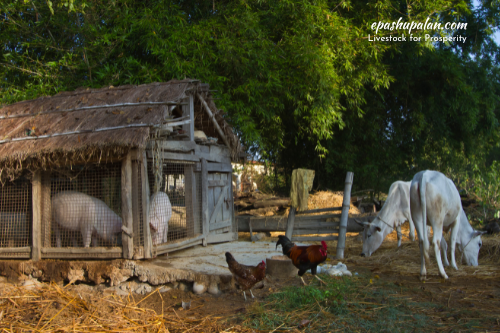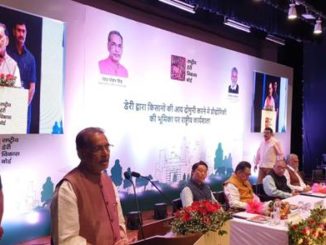The fact that growth in small farm agriculture critically depends on the performance of the supportive institutions has been repeatedly emphasized by many report. Additionally, time to time reforms in the institutions responsible for agricultural research, extension, credit and marketing are utmost necessary, in order to enable them to perform their expected roles and contribute to the growth of the income and welfare of the farming community. Few important aspects of these are:
Agricultural research
The growth in agriculture will be largely based on the development of improved technologies and their timely widespread dissemination among the farmers. Agricultural research and the transfer of improved technologies has to be a prime growth provider for ensuring sustainable growth in the future. In relation to this, the results are not very promising in Indian context as even the developed technologies have not been widely adopted by the farmers.
Extension
As in several parts of the country, the weakest link in agriculture sector is proper extension set-up. This is evident from the fact that a nation-wide survey of farmers conducted by the NSSO in 2003 reported that only about 5.7 per cent of the farmers, received information on modern technology from extension workers.
Credit
Institutional credit is a pre-requisite for increasing agricultural production and its value addition because most of the farmers (more than 90 per cent of the farm households) belong to marginal and small categories (owning <2 ha of land), whose income is not even sufficient to meet their daily consumption requirements. In context to this, the institutional agricultural credit flow has been inadequate and farmers depend more on non-institutional sources for meeting their credit requirements. Marginal and small farmers, who have no collateral to offer for mortgage, and tenant farmers who have no title to land, and are incapable of following the required procedural formalities to access formal sources, prefer to approach the easily accessible non-institutional sources such as moneylenders and traders, who charge high interest rate (50 to 120 per cent/per annum). In this regard the following schemes must be strengthened and revised time to time.
Kisan Credit Card
The Kisaan Credit Card (KCC) scheme is a credit scheme introduced in August 1998 by Indian public sector banks. This model scheme was prepared by the National Bank for Agriculture and Rural Development (NABARD) on the recommendations of the R. V. Gupta Committee to provide advances for agricultural needs. The Kisan Credit Card (KCC) has emerged as an important means of increasing short-term agricultural credit. But the number of KCCs were meager and needs to be increased to fulfill the goal behind it.
Micro Finance
The main cause of farmers suicides in India is high debt. And since these farmers don’t have protection under any limited liability laws, nor are their bonuses protected, they stand to lose their land, and pass on their liability to their helpless children. Self-help Groups (SHGs), Joint Liability Groups and Farmers’ Clubs facilitate the disbursement of trouble-free loans to the weaker sections of society. These organizations are gaining ground in other parts of the country.
Co-operatives
Co-operatives are still considered as the most suitable organizations for providing credit to farmers. The states with strong co-operative institutions are still excelling in providing agricultural credit to farmers.
Marketing
The Steering Group considers improvement in marketing as equally important for realizing fair prices for agricultural produce. Farmers are not able to sell their surplus produce remuneratively and there are widespread distress sales, particularly by marginal and small farm households. Keeping in view the scale and the objectives of agricultural growth envisaged in the coming years, the problems inherent in the systems and structures of agricultural marketing have to be addressed on a priority basis. In order to ensure efficient marketing, the following steps need to be taken:
Encouragement to the organization of genuine co-operative marketing societies
Except for the dairy sector, there are no genuine co-operative marketing societies. Various models of the traditional as well ‘new style’ co-operatives need to be encouraged, and be allowed to function without bureaucratic interference and with professional management.
Encouragement to contract farming
Vertical integration with large marketing and agro-processing firms should be encouraged. Care has to be taken to keep all such contacts transparent and fair. Dispute settlement arrangements should be in place at the local level.

Strengthening marketing infrastructure
The number of marketplaces should be increased to bring it close to the all-India level. Facilities at the designated marketplaces should be upgraded and made more attractive. A massive programme of construction of rural godowns and cold storages should be undertaken. Private sector participation in these investments should be encouraged either independently or as part of supply chains. Arrangements should be made with the credit institutions to ensure that they honour warehouse receipts and pledges.
Comprehensive and timely information on agricultural prices
The producers should be provided relevant and accurate information on prices and market arrivals, by establishing IT-enabled village information kiosks all over the state. Forward markets need to be made operative with the overall guidance of the Forward Market Commission.
Removal of policy hurdles
Legislation and government orders impinging on agricultural marketing should be constantly reviewed and amended to meet exigencies.
Encouragement to adherence to standards and grades
In order to make this possible, an awareness campaign should be launched, and facilities should be created for examining standards and sorting out products according to well established grades.
Crop insurance
In India where there is wide volatility in crop output due to natural disasters, crop insurance should be given due priority. Unfortunately, this is a much neglected aspect in the country. The nature of agricultural risk, status of crop insurance, and measures to improve performance must be addressed properly to support IFS.
| The content of the articles are accurate and true to the best of the author’s knowledge. It is not meant to substitute for diagnosis, prognosis, treatment, prescription, or formal and individualized advice from a veterinary medical professional. Animals exhibiting signs and symptoms of distress should be seen by a veterinarian immediately. |







Be the first to comment